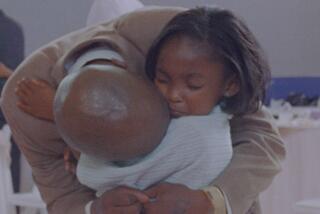The Nation : Personal Perspective : Recognizing the Value of Women’s Daily Lives
- Share via
NEW YORK — When I was in fourth grade, Sister Theresa asked my class to draw pictures of what we wanted to be when we grew up. It was 1962, and I at Blessed Sacramento School in Trenton, N.J. I drew a nun, a mommy and a teacher. These were the jobs I had seen a woman do.
In my professional life, I have worked as a union organizer, in two state governments, as a presidential advance woman. I am now the owner of my own communications company. Growing up, I watched my mother painting portraits--and I’m still in awe that she also managed to cook, clean, raise five children, be a wife to my father, take care of her mother, teach other people’s children and find time to register voters and volunteer.
This vision of my mother and the countless other involved women I’ve met inspired “Take Our Daughters To Work” day and a new campaign, “Picture What Women Do,” on May 17.
The objective of “Take Our Daughters to Work” is to make girls “visible, valued and heard.” This international public-education campaign was created to respond to alarming studies that show adolescence taking a serious toll on girls. The onset of the teen-age years all too regularly brings loss of confidence, eating disorders, physical and sexual abuse, negative body image and neglect. Other studies show girls receive less attention than boys in the classroom and less encouragement about their future.
A few months before I saw this data, I was at a benefit dinner. The keynote speaker, in his remarks, read a poem written by his 11-year-old daughter. His recognition of her in front of an audience of 3,000 overwhelmed me. His evident regard for what she had to say made me remember how important it was for me, as a child, to be acknowledged and taken seriously. I thought about this as I read the research data on girls. What resulted was “Take Our Daughters to Work.”
The program has produced many success stories. Last year, one group of girls attended a board meeting at Acacia Mutual Life Insurance in Washington. The subject was how the company should invest its money. A board member asked the girls what they thought about a life-insurance company investing money in tobacco companies. The girls said it was silly for a company that insures people’s lives to put its money into something known to kill people. After the girls lobbied their parents for months, company officials decided to heed the wisdom of their daughters and stop investing in cigarettes.
The combination of strength, care, ambition, love and sense of community that women bring to their work are seldom acknowledged, let alone rewarded. On May 17, women participating in “Picture What Women Do,” developed with Lifetime Television, will record their daily lives by having their husbands, friends, children, partners and co-workers photograph them in their homes, on the job and in their communities. It will be a portrait of contemporary women.
In a sense, how to value women and what they do--or rather, how to direct attention to the value that women’s lives possess--is the question.
Girls get the message in adolescence that they are supposed to be sweet--and quiet. Their looks and appeal to boys are most important. But they discover almost as soon as they enter the work world that if they want to succeed, they must be aggressive, powerful and well-paid. I’ve sought to redefine success, to redefine value--to let women be like women. “Picture What Women Do” and “Take Our Daughters To Work” generate a lens through which women can regard women as they truly are, a lens through which girls can envision their womanhood with excitement, not endless conflict.
In 1993, 1 million girls punched the clock at offices and opera houses, retail stores and news rooms, hospitals and universities on “Take Our Daughters To Work” day. This year, more than 3 million went to work around the globe.
In Los Angeles, Metrolink offered free rides to girls commuting with an adult. Seven fathers from the Department of Street Lighting hosted 10 daughters, repairing street lights in a maintenance yard. The Watts Health Foundation showed the ins and outs of running an urban community health center.
If “Take Our Daughters To Work” is about the future of women, “Picture What Women Do” is about the present. It will give women an opportunity to record for themselves, for girls, for the men and boys in their lives the choices we have now and the things we still want to change. But more more than just two special days of recognition for the lives women lead is at stake. The goal is a continuing dialogue toward improving the quality of the lives of women, men and children.*
More to Read
Sign up for Essential California
The most important California stories and recommendations in your inbox every morning.
You may occasionally receive promotional content from the Los Angeles Times.













